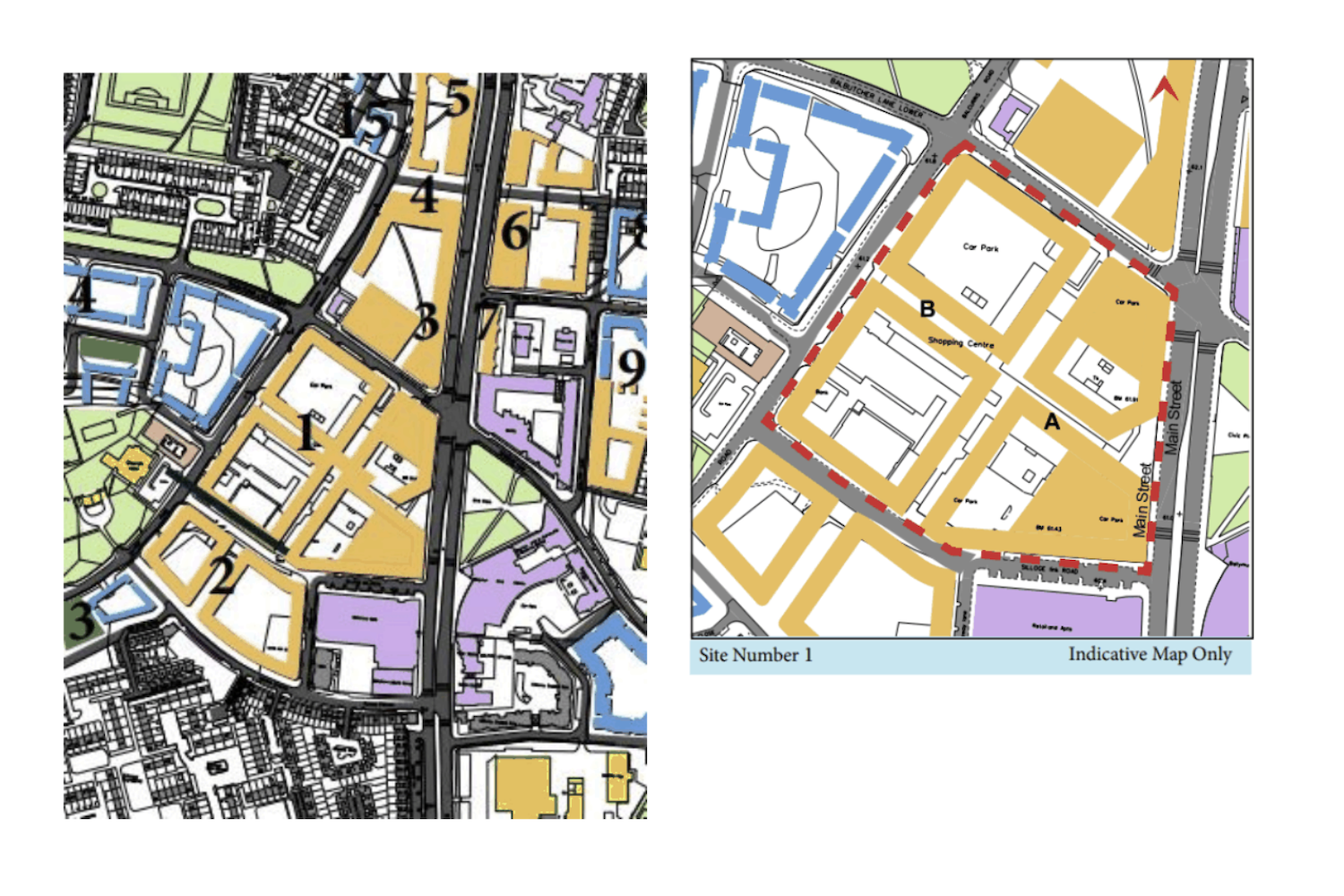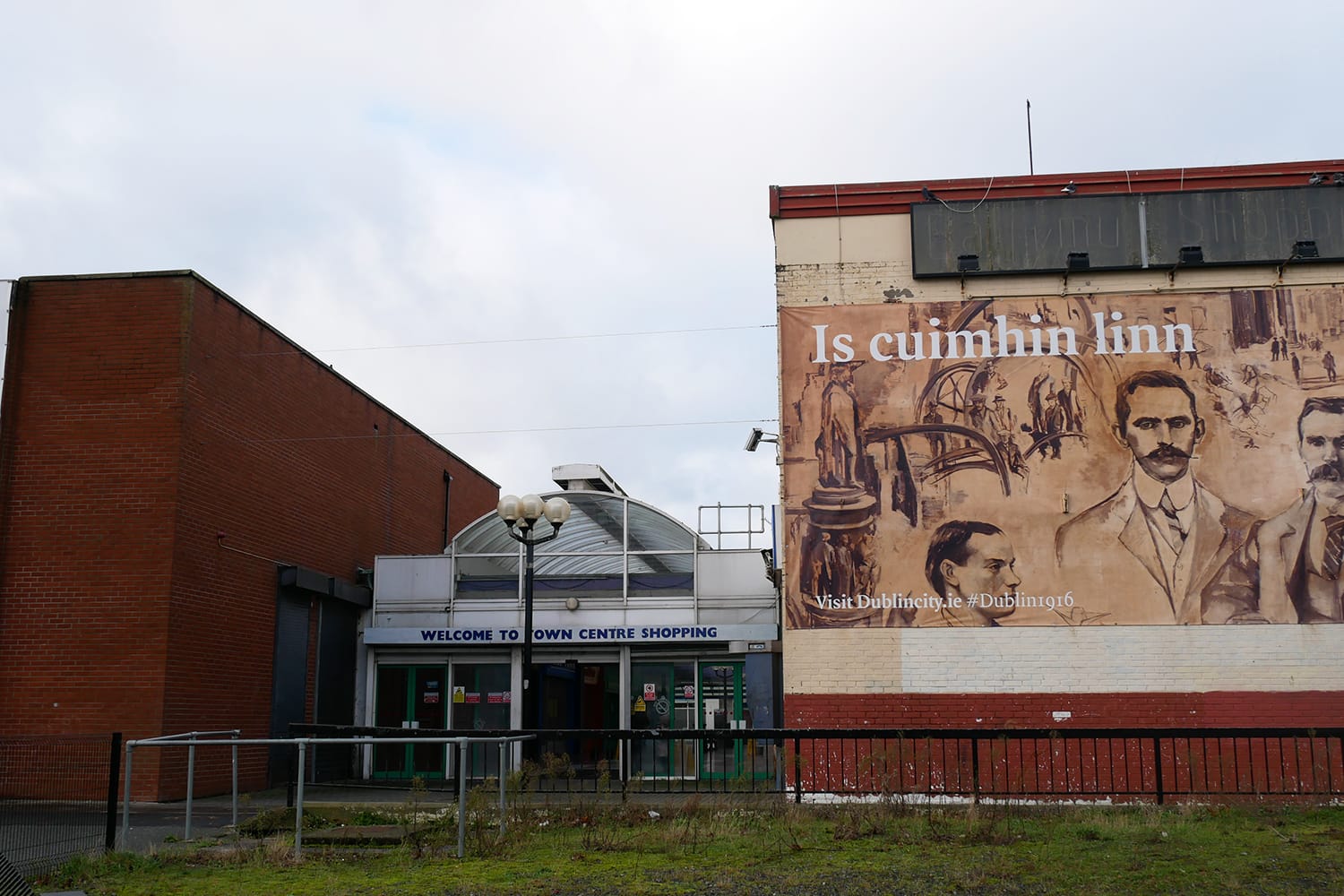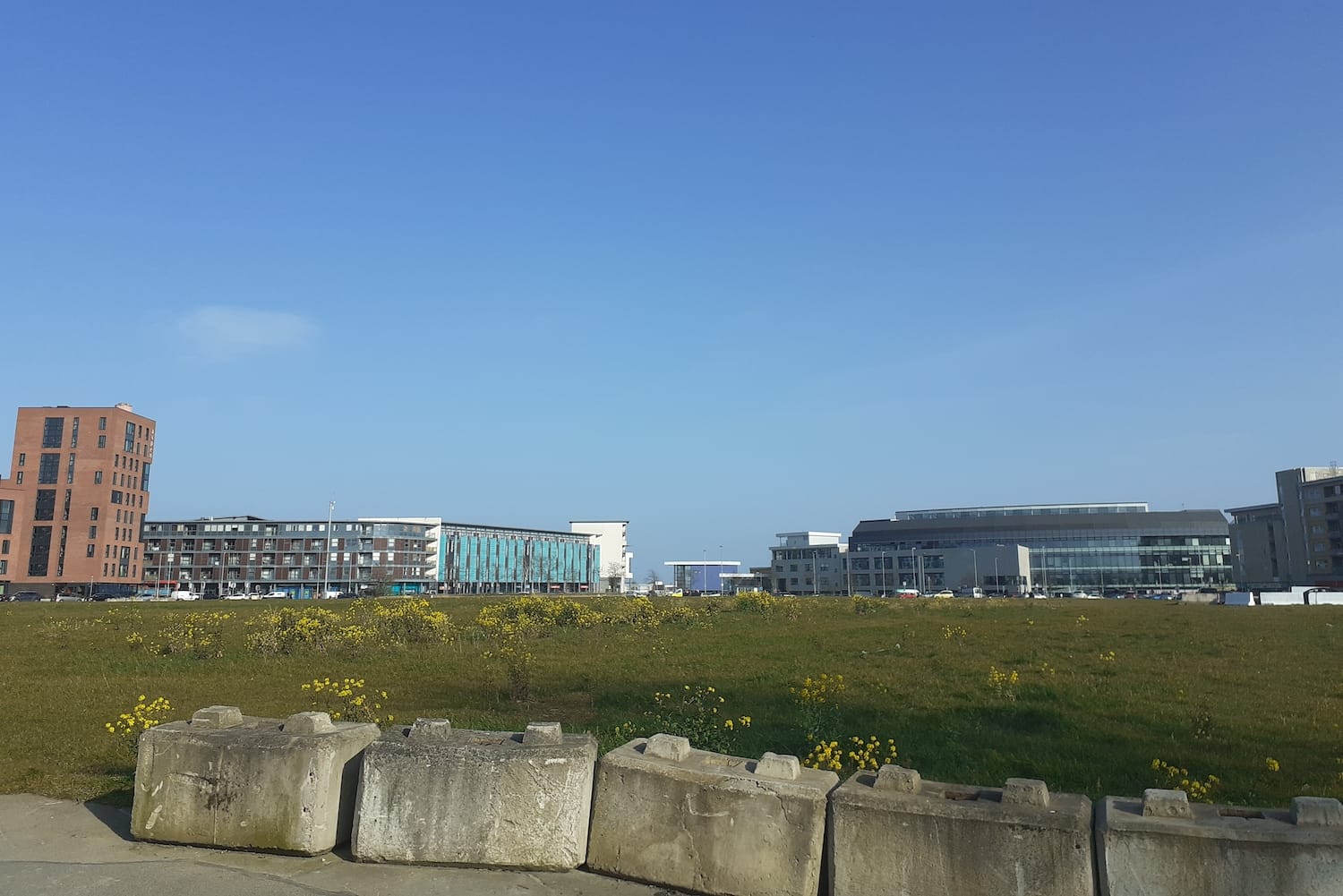What’s the best way to tell area residents about plans for a new asylum shelter nearby?
The government should tell communities directly about plans for new asylum shelters, some activists and politicians say.
Local councillors are unanimous in wanting more than just housing, saying there should be shops, children’s play areas, a pub. Past plans to redevelop the site with private developers have, time and again, fallen through.

In Ballymun on Tuesday, Kerry Connelly was walking along Silloge Road, passing the western side of a vast field with her stepdaughter.
Connelly doesn’t like the look of the blank grass to her right, which stretches all the way over to Main Street.
“I don’t like that it’s empty, because there’s nothing there. I don’t walk through it, I walk around it,” she says.
In the coming months, Dublin City Council plans to put out feelers to see who might be interested in developing this vacant site where the Ballymun Shopping Centre used to stand, says a recent report to councillors.
The Ballymun Local Area Plan shows space for around 300 homes at the western side of the lands, and 41,000 sqm of shops, offices or apartments at the eastern front where it meets Main Street, the thoroughfare through the centre of the neighbourhood.
The council has two separate plans for the two sides of the 3.2 ha cleared site.
It wants to sound out the market to see who might want to develop the western blocks into a permanent development of homes, and more.
Its idea for the eastern part of the site, next to Main Street is for temporary uses to draw people in with markets, say, or pop-up food stalls or an ice rink. Metrolink plans means a more permanent development will have to wait, councillors say.
In the Ballymun Masterplan for the regeneration of the suburb, created in 1997, this site was to be the heart of the shopping district of Ballymun.
In November 2008, Treasury Holdings unveiled plans for a massive complex called Spring Cross, with hundreds of thousands of square feet of shops, leisure space, and offices, an 11-screen cinema, a bowling alley, and more than 300 apartments. Then came the financial crash.
In December 2014, the council bought the shopping centre land. There was another false start in 2015, after councillors agreed to sell the site for a new smaller shopping centre, but that deal too fell apart.
Nine months ago, the council pulled down the shopping centre, clearing the way for the next push to develop the site.
The shopping centre that’s been demolished was once the town centre of Ballymun, says Mary Callaghan, a Social Democrats councillor.
For years, people have been asking what is coming next, she says. “Because they feel that the shopping centre used to be the heart of Ballymun. But it’s no longer there.”

For the western part of the site, the council plans to do its “market soundings” between now and the end of September, to see who might be interested in developing all or part of it, says the report to councillors.
The council wants a focus on homes, but also spaces for jobs or educational uses, it says, while the ground floors should be used for the kinds of things that the public can access – like a pub, children’s play area, crèche, or gym.
Connelly would like all of those things, she says.
A new café Ren’s Deli opened not long ago in central Ballymun and it was really needed, she says. “I’d be going out to Finglas, just to have a coffee with friends from here.”
But for the evening, there should be a pub, too, she says. “There’s nowhere to go that I can just walk home after a couple of drinks or something like that.”
It’s tricky to come up with something that will work, says Keith Connolly, a Fianna Fáil councillor. “There’s no real funding there at the moment.”
Callaghan, the Social Democrats councillor, says that arranging an anchor tenant for the development would make sense, to be sure the economics stack up. “If a developer comes in and builds something, they need to make sure that they can rent it out.”
One option she has put forward is for a government body, or the Health Service Executive, to commit to an office there, she says.
Connolly, the Fianna Fáil councillor, says the council plans to ask the City of Dublin Education and Training Board, which supports and coordinates education services, too. “They’re basically writing to everyone they can.”
The community wants a meeting place and more social spaces, says Callaghan. “Something that kind of represents what used to be there before. The difficulty is in economic terms, it’s very difficult to build something like that.”
“I think Ballymun is really coming along. There’s been a huge amount of money put into it over the years. It needs more community activities,” she says. “There’s one pub, but it’s attached to a hotel.”
Ballymun has a plan for a city farm, she says, and a new plaza that’s planned to be built this year. There’s the Rediscovery Centre, too.
Callaghan, the Social Democrats councillor, says she thinks that the housing on the site would likely be a mix of social housing and affordable, cost rental and private.
Robert Murphy, a local businessman, says that if Ballymun is to have a vibrant local economy, there needs to be a greater mix of incomes in the area.
“Disposable income is very low in Ballymun I feel, and unfortunately people don’t have the choices they’d like to have,” he says.
The homes should be cost-rental or affordable purchase, he says, and the government needs to get approved housing bodies interested in Ballymun. “Because they’re all failing us.”

Councillors are unanimous in not wanting only housing on the site, says Connolly. “Definitely to have elements of retail, perhaps a restaurant, pub, couple of anchor shops, no problem with apartments above it. I think the community expects that.”
In 2019, Dublin City Council asked Bannon estate agents for advice on how to make retail sustainable on the Ballymun lands.
It’s been hard in the past to keep retail open, and council shop fronts within some of the Ballymun neighbourhoods have stayed empty for years.
Bannon’s advice to the council was “to provide innovative retail concepts that complement and differentiate from the existing retail market”, says the report to councillors in the North West Area.
Connolly, the Fianna Fáil councillor, says some supermarkets haven’t been as successful as they thought.
“Stores like Dealz for example, and Lidl, who are there at the moment, say they haven’t been doing as well as expected. So that would be a bit of a worry,” he says.
This is partly because of the low spending power in Ballymun, says Connolly. “Quite low compared to other parts of the city.”
Says Anthony Connaghan, a Sinn Féin councillor: “You’d love someone to come in and just be able to have the funds to redevelop the whole site into a big shopping centre, as kind of was promised years ago.”
In early 2018, a local community group, in which Murphy was involved, put out a different vision and model for the site, one of a community-operated shopping centre with profits fed back into area projects – but it would have meant the council selling the land at a token price to make it possible.
Murphy says he doesn’t think councillors consult with locals. “I think there’s a big disconnect now between local councillors and the local businesses and the people.”
Councillors okayed the next steps at a meeting of their North West Area Committee on 15 March.
They had already met separately with council officials to talk about it, said Connolly, the Fianna Fáil councillor and committee chair.
At that earlier meeting, councillors and the council officials had kicked around ideas for what could fill the eastern side of the site, which looks onto Main Street.
The idea for now is to throw up short-term attractions. “To bring people into the area from the immediate hinterland and to foster a positive image of the site, helping to reimagine the space in the minds of retailers and residents alike,” says the council report.
From April, the council plans to ask for “expressions of interest” from people or businesses wanting to run stalls, craft markets, funfairs. Particularly over the summer and Christmas, it says.
Connaghan, the Sinn Féin councillor, says an ice rink would be good as they attract people from all over. “Which is good for the local shops.”
Connolly, the councillor, says supporting that kind of temporary use wouldn’t cost a lot.
“You’d have to make sure there’s proper access and stuff, but it wouldn’t be a massive financial burden for the council to bring out a temporary use to happen quite quickly I’d imagine,” he says.
Says the council report: “Depending on interest a pilot project is proposed in May / June.” That will help the council understand what they may need to put in on that part of the site, like footpaths and benches.
Longer-term, the eastern part of the site should have lots of shops and maybe cultural spaces, says the local area plan. The buildings may or may not be integrated with the planned Metrolink station.
Metrolink is the underground rail line proposed to run from Dublin Airport to Charlemont, on the Grand Canal, with a stop in Ballymun.
It is due to be completed in 2034 and that’s one reason why, councillors say, building out this part of the land may take much longer.

The Metrolink station could take years, says Caroline Conroy, a Green Party councillor. “Us councillors feel that’s kind of a waste.”
Conroy says she hopes that eventually there could be a comfortable central plaza, along with homes and shops, around the Metrolink station.
“In the long term, I think it needs to be planned well,” she says. “It should be somewhere where people in the community can come together and have a more central feel to the town.”
Metrolink would change a lot about Ballymun, says Connolly. “I mean it could be a totally different scenario there, and it could be much more vibrant.”
The slow progress of Metrolink has had a knock-on effect on the council’s plans for housing in Ballymun, he says.
“It’s state land that should be built on in the middle of a housing crisis, but if you don’t have public infrastructure, you don’t have public transport, it’s going to obviously have an impact on that,” he says.
Says Connaghan: “I would imagine that if you knew that that metro was going in next year, you would have people probably bidding on that site, to put some kind of a shopping centre in there.”
Murphy, the local businessman, says that the site shouldn’t wait for the Metrolink.
“I don’t want billions of euro spent on an underground train, and to be honest with you, it’s feeling, from an environmental POV, I don’t wanna be fuelling that airport anymore,” he says.
“They need to build on that site, feck the Metro,” he said. “Ballymun is waiting and waiting and waiting.”
Get our latest headlines in one of them, and recommendations for things to do in Dublin in the other.